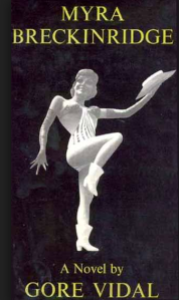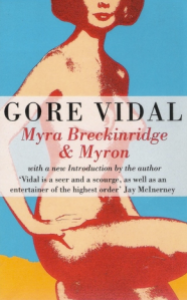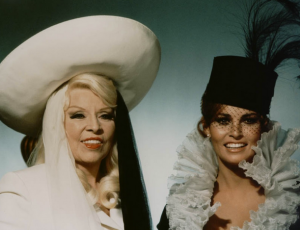Conceivably, there has never been a bawdier broad in the annals (a deliberate word choice) of literature than Myra Breckinridge. The conniving film connoisseur–“Golden Age” film to be exact–knows what she wants and will take whatever means necessary to get it. As a bisexual leaning toward gay (a classification Myra would abhor), Gore Vidal was the ideal author to take on the persona of a transsexual looking to eradicate all pre-established notions of gender.

In addition to parodying the concept of gender norms, so, too, does Vidal poke fun at the absurdity of Hollywood and the cult of acting. Case in point is Myra teaching classes in Posture and Empathy. As a screenwriter in addition to novelist, Vidal knew all too well both sides of the intellectual and pseudo-intellectual coin. Vidal as Myra notes that people from the East merely “read books about books.” And while West Coastians are superficial, at least they own said superficiality. On this, Myra observes that it is easy to be “entirely absorbed by California, that great sponge into which all things are drawn and promptly homogenized, including Judaism.”

But back to Myra’s sexuality, or rather, destruction of it. Acting as Myron Breckinridge’s widow, she inserts herself into his uncle’s (Buck Loner) acting school as a teacher, though her true didactic ability lies in instructing a student named Rusty Godowsky on how to be emasculated. After raping him with a dildo in an exam room, Myra transforms Rusty into an angry “lovemaker,” which appeals to star-making bigwig Letitia Van Allen (played in the much panned film version by, appropriately, Mae West).

As for Rusty’s former girlfriend, Mary Ann, well, Myra sees to it that she is taken under her wing. Though, much to her dismay, Mary Ann seems to have zero lesbianic tendencies whatsoever–at least in the area where it counts. Myra’s continued annihilation of conventional views on relationships, as well as the male and female sexual psyche as represented by Rusty and Mary Ann, is an art form perfected in the climax of the novel, in which she reveals her, to borrow a phrase from The Mighty Boosh, downstairs mix up.

The very idea that Myra Breckinridge as both person and novel could still hold so much clout in the realm of gender studies and all things gay and trans is a testament to Vidal’s prophet-like writing. And the fact that Myra’s character could withstand a portrayal by Raquel Welch is also saying something of its transcendent resonance.




















[…] Apart from being generally offensive (indubitably caused, in part, by the era in which he thrived), Rooney was also notorious for his inability to stay married for long periods of time. In total, he wed eight women, leading him to ineloquently quip, ”Always get married early in the morning. That way, if it doesn’t work out, you haven’t wasted a whole day.” Regardless of Rooney’s many faux pas with regard to tact, he will always sustain a loyal and laudatory audience, if in no one other than Myra Breckinridge–the last devotee of Golden Age Hollywood. […]
[…] once again, new methods of destruction of an even more devious nature would come to fruition (e.g. Myra Breckinridge-level humiliation). Cameos by the likes of Madonna, Lindsay Lohan and, once again, Maggie Smith and […]